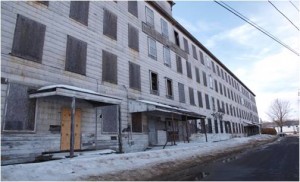James Kostaras, Senior Research Associate, AIA, AICP
As a consequence of a turbulent economy, dysfunctional politics and drastic federal budgets cuts, a looming fiscal crisis will break municipal government in the United States, particularly in cities that have lost jobs and their industrial base. Building upon its international experience, I2UD is exploring ways to assist smaller economically distressed cities in America.
Joel Kotkin, a former Senior Research Fellow at the New America Foundation, writing in Forbes says, “In the next two years, America’s [large] cities will face the greatest existential crisis in a generation.” Smaller former industrial cities, as we noted previously in this blog, are in “triage” mode as they struggle mightily to provide services in the face of budget cuts, staff reductions and cuts in state aid, reducing the core functions of municipal government to police, fire, schools and streets. More daunting are the unfunded pension obligations of municipal workers, exploding health insurance costs and the diminishing property tax revenue due to a battered real estate market. The political risks for local government pose a dilemma: municipal governments stressed by budget cuts without adequate resources perform badly, leading to further demands for severe budget cuts from a disillusioned public, exacerbating performance problems and creating a vicious cycle.

I2UD Research
In response, I2UD is completing an analysis of selected Massachusetts cities and towns, faced in recent years with fiscal crisis, economic stress and diminishing State and Federal funding. The objective is to assess the capacity of these cities to formulate creative strategies to ensure their long-term economic competitiveness, deliver essential services and address problems of urban poverty. Since June 2011, Kendra Leith, Research Associate, and Lu Gao, Research Intern, have collected data from the Massachusetts Department of Revenue and 2010 U.S. Census for 36 cities in the Commonwealth of Massachusetts, primarily post-industrial cities with populations of 100,000 or less. Our analysis and findings predictably confirm a range of assumptions, some of which include the following:
- Poverty. Former industrial cities tend to have higher poverty rates, although there is no consistent pattern across the spectrum of the selected cities in terms of the increase or decrease of poverty rates from 2000-2010.
- Immigration. Immigrants have been a significant and increasing percentage of the population in the former industrial cities. A critical research objective, in the future, might be to determine the extent to which immigrants’ investment and participation in the local economy have revitalized or ‘propped up’ distressed cities during the national economic crisis — or alternatively been a burden to these communities in terms of social services.
- Diminishing Property Tax Base. Selected cities differ significantly in their capacity to generate local revenue through property taxes during the 2000-2010 period. Some cities have a strong sustaining tax base with over 70% of revenue coming from local property tax; others rely heavily on the financial aid from the State and can only collect 30% of local revenue from their own property tax base. This reflects a broader dilemma for municipal government in the U.S. As the National League of Cities recently reports, “One of the main culprits is the property tax, which many cities and local governments rely on heavily. Property tax collections, which are usually quite resilient, are projected to fall by 3.7 percent this year — their second year in a row of declines — as tax assessments belatedly catch up with the lower property values left behind by the battered real estate market…. For cities, the collective impact of property values continuing at levels far below their 2007 peaks, consumer spending slowing, consumer confidence eroding and markets possibly entering a double-dip recession is the worst since the Great Depression.”
Interviews with Municipal Officials in Massachusetts
Informed by this data analysis, I2UD has also interviewed elected officials, city planning and economic development directors, and representatives from community development agencies in several selected cities since July 2011 to explore a prospective role for I2UD in helping to build the capacity of these communities to develop innovative interventions strategies, reverse their economic decline and continue to provide essential services to their communities.
Does I2UD have a viable role in helping to build the capacity of local governments in U.S. cities?
Undertaking this ‘pilot’ research project over the past three months has given us an opportunity to consider several questions pertaining to the value of and prospects for I2UD U.S.-based work in cities in crisis.
Do municipal governments have a real need for and interest in I2UD’s services and expertise, notwithstanding the scope and impact of the current crisis?
Interviewed municipal stakeholders identified difficulties in meeting critical short-term needs with less staff and constrained budgets leave them with a limited capacity to plan strategically for mid- and long-term economic development. In fact, several cities were very enthusiastic about involving I2UD in several specific tasks or services that they have limited capacity to undertake including:
- Grant writing for competitive federal and state government funding
- Developing master plans and urban design guidelines
- Preparing economic development plans
- Generating comprehensive community development strategies
- Provide training for planning and economic development staff within city government
- Developing programs to provide technical assistance for small businesses
- Offering training programs in community participation, consensus building, and negotiation to municipal staff
- Documenting and disseminating best practices
What would be the funding strategy to support either research or pro bono consulting work by I2UD to assist distressed U.S. cities?
As an initial inquiry, we identified foundations and corporate-giving entities within private sector organizations that might offer potential funding on a competitive basis for an I2UD pilot project to provide the cities with technical assistance on a no-cost basis to prepare a development strategy and other requested services.
Assuming the availability of funding, is U.S.-based work in this area resonant with I2UD’s long-term international strategy, in terms of the organization’s capacity and allocation of staff time?
This question will require a broader, more strategic discussion within I2UD once this analysis and assessment are complete.
An I2UD ‘Learning Network’ of Smaller U.S. Cities
The discovery of innovative strategies and approaches to urban development by entrepreneurial planners and other officials in local government in several of these cities, even in the face of economic headwinds and diminishing federal and state aid, was an unanticipated outcome of the interviews. Some of these innovations include a municipal solar power facility, creative development of tax-foreclosed properties in collaboration with community-base organizations and a city-owned farm and apple orchard that generate a profit supplementing the otherwise constrained municipal budget. On a parallel track with the capacity-building project, I2UD might assume a role in documenting and disseminating these ‘innovative practices’, many of which might contribute to the future fiscal sustainability of communities in crisis, through a ‘learning network of cities’.
Mr. Kostaras’ article, “What I Learned: An Insider’s Guide to Improving Local Government, Modest proposals for fixing local government in America” appeared in ArchitectureBoston’s Summer 2011 issue.
Top photo: Renovated mill in Holyoke, MA; Second photo: Run-down mill in Leominster, MA; credits: I2UD

